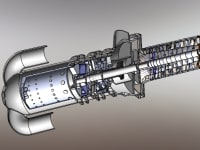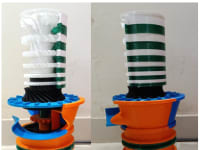This project focuses on the design, development, and manufacturing of a small-scale turboprop engine. The goal is to create an efficient and reliable propulsion system using advanced engineering principles and 3D printing.
The engine design includes both axial and centrifugal compressors for optimal air compression. The axial compressor, located at the front, compresses incoming air through multiple rotor and stator stages. This compressed air then moves to the centrifugal compressor, which further increases the pressure. Combining these compressors achieves higher compression ratios and improved efficiency.
The engine operates with gas generator and free turbines that function independently. The gas generator turbine extracts energy from high-pressure, high-temperature gases from the combustion chamber. This turbine powers the axial and centrifugal compressors, ensuring continuous air compression. The free turbine, which is mechanically separate from the gas generator turbine, uses the remaining exhaust energy to drive the propeller, providing thrust. The free turbine is connected to the gear box that reduces the speed and then connected to the propeller.
The combustion chamber is placed after the compressors, allowing high-pressure air to bypass the turbines and enter the chamber. Here, the air mixes with fuel and ignites, creating high-energy airflow. This airflow then passes through the turbines, first driving the gas generator turbine and then the free turbine, before exiting through the exhaust. The combustion chamber is designed for efficient fuel-air mixing and stable combustion, producing high-energy output for the turbines.
The engine components are manufactured using 3D printing, which offers precision and flexibility. Key parts such as compressor blades, turbine rotors, and casings are produced with this method. 3D printing reduces production time and costs and allows for rapid prototyping and design improvements. It enables the creation of complex geometries and lightweight structures with high precision.
A novel aspect of this research is the independent rotation of the gas generator and free turbines, enhancing the engine’s operational flexibility and efficiency. This setup allows for optimized performance in both power generation and propulsion stages. The combination of axial and centrifugal compressors represents an innovative approach to achieving higher compression ratios and improving overall performance.
This project not only examines the theoretical aspects of turboprop engine design but also provides practical insights into manufacturability using advanced technologies. The successful design, 3D printing, and testing of engine components demonstrate the feasibility and benefits of integrating modern engineering techniques with traditional propulsion systems.
Like this entry?
-
About the Entrant
- Name:Harsh Shah
- Type of entry:individual
- Patent status:none





